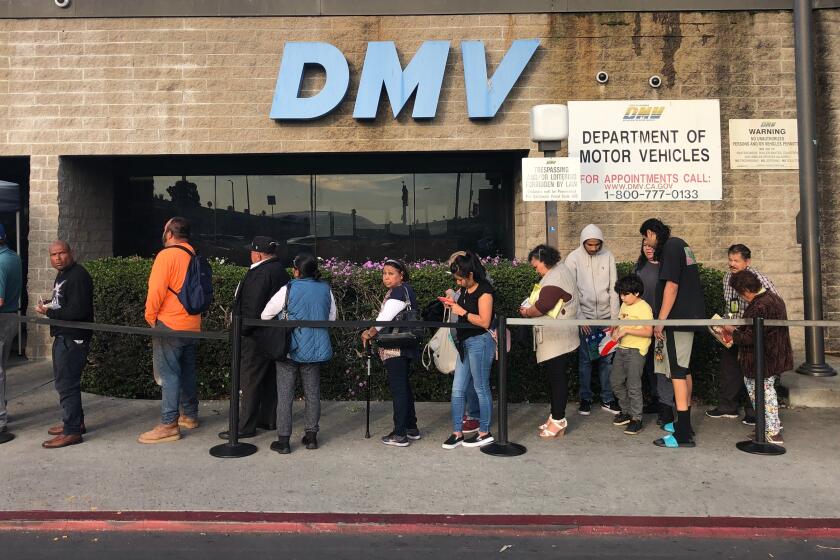Los Angeles’ ‘green zone’ plan is aimed at low-income, high-pollution areas
- Share via
For more than four decades, a grimy, rough-edged stretch of Branford Street in Pacoima has been known as Dismantler Row: a stronghold of metal recyclers, trucking yards, rock cutters, salvage yards and auto body shops.
Oily water streams out of yards each day, fills the cracks and potholes of the street’s narrow, asphalt lanes and gushes into storm drains and downstream to the sea. Shops without names hack and hammer at cars in alleyways strewn with discarded tires and trash. Saws and sanders blow granite dust out doors and windows like a white fog.
Residents of surrounding neighborhoods have had enough. “It’s time to clean that place up,” Pacoima resident Reyna Hernandez, a 38-year-old mother of six, said in Spanish. “There is nothing more important than the health of our children and elderly.”
Hernandez belongs to a coalition of grassroots organizations that is backing an aggressive pollution control plan designed to clean up and green up the low-income L.A. communities of Pacoima, Boyle Heights and Wilmington — all “toxic hot spot” neighborhoods saturated with poorly controlled environmental hazards.
Under a motion to be introduced Friday by four Los Angeles City Council members, these communities would be designated as special “green zone” districts. The aim would be to attract clean industries through incentives, including help obtaining permits and tax and utility rebates. Polluters, meanwhile, would be targeted with tougher inspection and enforcement protocols.
“This is a groundbreaking effort to use municipal planning and enforcement strategies to address cumulative impacts in these communities,” said Gideon Kracov, an environmental lawyer and consultant to the coalition called Los Angeles Collaborative for Environmental Health and Justice.
“It also shows that the environmental justice movement is shifting to building more sustainable communities instead of fighting facilities smokestack to smokestack,” Kracov said.
Manuel Pastor, director of USC’s Program for Environmental and Regional Equity, said that “in some of these neighborhoods there is no place that is not within 1,000 feet of a significant pollution hazard such as chrome-plating businesses, heavy industry and adjacent freeways. The synergistic effect of these hazards remains unknown.”
Nationwide, Lisa Jackson, the first African American to head the Environmental Protection Agency, has declared environmental justice a top priority. She has toured low-income neighborhoods that have high concentrations of pollution-causing industries, administering grants to engage and educate residents about confronting pollution hazards.
“I believe this proposal is an innovative concept in trying to address the environmental burden that has been placed on a lot of these communities,” said Lisa Garcia, head of the EPA’s environmental justice program. “We’re following it closely.”
Some Pacoima residents said they were prepared to risk losing economically beneficial businesses, if necessary, to reduce the pollution sources in their neighborhoods. “We understand that some businesses may decide to leave,” Hernandez said. “But in the long term, a cleaner environment, and the financial incentives, will bring in new industries that will supply the jobs we lost.”
Statewide, polluted air causes 19,000 premature deaths annually, along with 280,000 cases of aggravated asthma, 1.9 million lost workdays and more than 1 million school absences, and costs over $25 million in hospital charges, according to the California Air Resources Board.
Hardest hit are children and the elderly, pregnant women and those living in poverty and poor housing with limited access to healthcare.
California has one of the nation’s largest concentrations of minorities living near hazardous chemical waste and air pollution produced by refineries, port operations, freeway traffic and railroads. An analysis of census data by researchers at four universities for the United Church of Christ showed that 1.2 million people in the Greater Los Angeles area, 91% of them minorities, live within two miles of facilities handling hazardous materials.
Yet, the air hazards in such communities as Boyle Heights and Pacoima are not fully identified by regulatory agencies because emissions of many smaller polluting facilities, including gas stations, print shops, window tinters and dry cleaners, are not recorded in government databases, according to a recent report by the Liberty Hill Foundation.
“This problem of incompatible land use has plagued Los Angeles city planners for generations,” Kracov said. “Unless we try this comprehensive approach, we are going to leave this problem for the generations to come.”
On Branford Street, many workers in the area’s estimated 27 granite fabrication shops said they prefer to work without face masks or goggles while fashioning slabs of rock into pricey kitchen table tops. At more than a dozen shops visited on a recent weekday, all were equipped with large ventilation fans, but only a few of those were operating. “The fans get clogged with dust, so they quit working,” one worker sheepishly explained.
At closing time, they use gas-powered blowers to blast layers of dust off their bodies, floors and walls and out into the open air.
“I worry about breathing the dust,” acknowledged Juan Cruz, who said he earns about $10 an hour as a granite fabricator. “What else can I say? It’s what I do for a living.”
Pacoima environmental activist Veronica Padilla, 30, believes the cleanup and green-up campaign could improve things for the employees of Branford Street and the surrounding neighborhoods.
“Several times over the past few years, we have gone into the area prepared to hand out free face masks and provide helpful advice,” Padilla said. “But the businesses’ owners wouldn’t even open their doors to hear us out, or lift a finger to be good neighbors.”
“All we want is cleaner air and some greener jobs,” she said.
More to Read
Sign up for Essential California
The most important California stories and recommendations in your inbox every morning.
You may occasionally receive promotional content from the Los Angeles Times.











